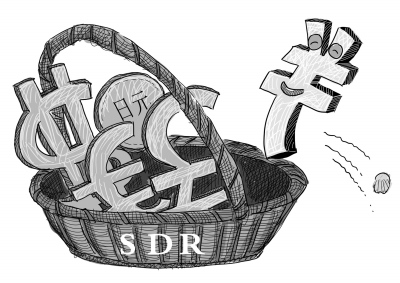The renminbi’s introduction into the SDR basket is a significant development in the process of international currency system reform. As IMF President Christine Lagarde said, the decision was an important milestone in the Chinese economy’s integration into the global financial regime.
In a certain sense, joining the SDR equals IMF endorsement of the RMB formally becoming an international reserve currency, marking a significant step forward in post-WWII international currency system reform. As an IMF invention to cope with the “Triffin Dilemma” of the Bretton Woods system, the SDR was meant to ease the inherent risks of sovereign currencies as reserve currencies.

However, the SDR has played a very limited role in the international currency system. By 2014, the proportion of SDR in the reserve assets of IMF member countries remained below 4 percent. By September 2015, the SDR quotas of all IMF member countries totaled only about $280 billion, as compared to the $11.3 trillion in global reserve assets. Structural imbalance turns out to be particularly evident. There were only four currencies in the SDR basket, with the US dollar accounting for 41.9 percent, the euro 37.4 percent, the British pound 11.3 percent, and the Japanese yen 9.4 percent. With all four currencies belonging to advanced economies, the SDR failed to reflect the functions of emerging economies in global economic and financial affairs. SDR quota reform was thus imperative.
The IMF reviews the SDR composition every five years. According to set standards, currencies in the SDR basket must satisfy two conditions: First, they must be issued by an IMF member state, or a currency alliance, and the economic entity has to have been one of the world’s four largest commodity and service exporters for five consecutive years prior to the year before the basket took effect; Second, the “free use” criterion, which means the currency must have been widely used in international transaction payments, and extensively transacted in major foreign-exchange markets.
Judging from current conditions, the RMB satisfies those two criteria. First, the process of cross-border use of the RMB is being accelerated. According to SWIFT statistics, the RMB had become the world’s second most important currency in trade and fund-raising, the fifth payment currency, and the sixth foreign-exchange currency. By August 2015, the RMB had surpassed the yen to become the fourth global payment currency with a market share of 2.79 percent, creating a historical high. The market shares of the first three, namely the dollar, euro and pound, were respectively 44.8 percent, 27.2 percent, and 8.5 percent.
Second, there have been almost 15 offshore RMB clearing centers. Since 2014, China has signed RMB clearance agreements with Great Britain, Germany, Luxemburg, France, and Switzerland. Since 2009, the country has signed currency-swap agreements with 33 countries, with a combined volume of 310.15 million yuan. Offshore RMB deposits have almost reached 2 trillion yuan, and offshore markets for RMB bonds (dim sum bonds) and other forms of RMB assets have developed rapidly.
The RMB’s SDR status will have far-reaching impact on international currency system reform. The weight of the other four currencies in the SDR basket, the dollar, euro, pound, and yen, will be reduced respectively to 41.73 percent, 30.93 percent, 8.09 percent, and 8.33 percent. The RMB’s weight will be 10.92 percent (though not as much as had been anticipated), becoming the third-most important currency, after the dollar and euro, in the SDR basket.
From a mid- and long-term perspective, the RMB’s admission into the SDR basket may be considered a significant milestone of its internationalization. According to the World Economic Outlook Database of the IMF, China became the world’s second largest economic entity in 2010. The RMB’s admission into the SDR basket will make the SDR itself more just and representative of the global economy. Second, adopting a fifth currency will also enhance stability of the SDR’s value. Third, it increases the options for member countries’ reserve currencies, and satisfies diversified demands. According to statistics, more than 50 central banks have introduced the RMB into their reserve assets. Fourth, it makes the SDR more attractive, and the RMB will also participate in the distribution of international seigniorage income.
The comprehensive benefits of the RMB’s entry into the SDR have just begun. The SDR status is only a fresh starting point for transforming China from a big financial entity into a strong financial powerhouse. It will prove even more effective as a booster for China to promote its own financial system reforms and improve efficiency of its financial market. In the future, China needs to take advantage of the RMB’s SDR status to actively adjust the structure of its reserve assets, and strive to build an investment and transaction as well as payment and settlement system, credit-rating system, and financial security guarantee system that are effective and operate globally, so as to upgrade the RMB’s global influence.


